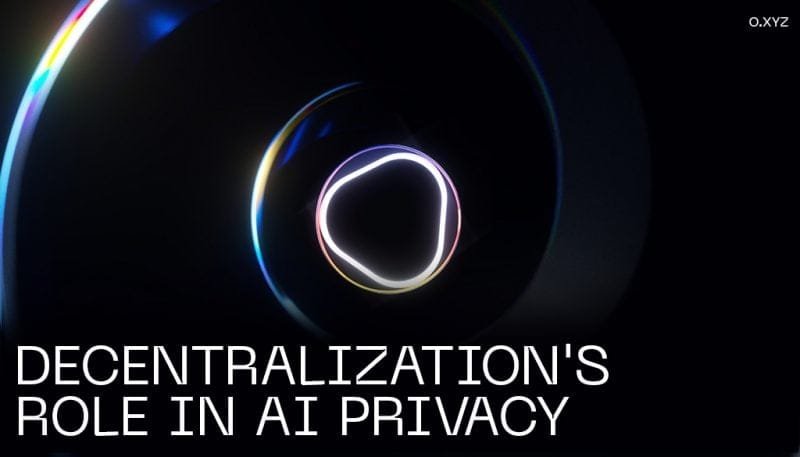Share this article
By Ahmad Shadid, founder of O.XYZ
There’s no doubt that we’re seeing unprecedented advances in artificial intelligence, but behind all of this progress lies a troubling reality: AI, as we know it, is far from private.
Dominated by a handful of centralized powers, our AI landscape revolves around the proprietary models of Google, Microsoft, Amazon, Meta and OpenAI. These companies not only control the development and application of the world’s most popular AI models, but they also hold vast amounts of user data, collected through millions of daily interactions with their platforms.
This data, often collected under the guise of “personalization,” powers predictive algorithms that go well beyond simple convenience. Whether it’s targeted advertising, political campaign strategies, or perhaps subtle steering of public opinion, the centralized paradigm of AI has created an ecosystem ripe for exploitation. We’ve had glimpses of this dystopian potential, from the Cambridge Analytica scandal to the surveillance economy reminiscent of Orwell’s 1984. In such a world, AI becomes a tool of control, not liberation. The pressing question then is: how do we move from a system that benefits from our data to one that respects it?
Decentralized AI: an answer to true privacy
Decentralized AI is a transformative vision that reinvents how AI itself works. Just as Bitcoin challenged centralized banking by providing transparency and autonomy, decentralized AI seeks to dismantle the centralized structures that dominate today. It paves the way for a world in which no one owns or controls information: a network built on the principles of confidentiality, transparency and community ownership.
In a decentralized AI ecosystem, data is no longer hoarded by companies but encrypted, secured and distributed between nodes in a blockchain-like structure. This ensures that user interactions with AI models remain private and untouchable by external actors. Decentralized AI offers an antidote to the status quo: a system in which power is returned to individuals and AI serves humanity rather than exploiting it.
The possibilities of decentralized AI are incredibly exciting: the technology and perspective that powers it are already revolutionizing aspects of our world and there is no doubt that this will continue to create opportunities for freedom. As it grows in popularity, understanding the path to fully decentralized AI is more complex than most imagine.
The challenges of true decentralization
Building truly private, decentralized AI doesn’t just mean further encrypting algorithms or coding AI models on a blockchain. This requires rethinking the entire infrastructure and end-to-end journey, from how AI is trained and on what data, to where it is deployed and maintained.
Decentralizing AI involves breaking ownership ties. This means reinventing not only technical systems, but also the organizational structures that underpin them. From the hardware used to power AI models to the governance frameworks that guide their development, decentralization requires a holistic overhaul.
At the hardware level, since today’s AI systems rely on centralized GPU networks controlled by a few companies, a decentralized computing infrastructure is perhaps the first major change that needs to be made. Centralized networks create supply chain vulnerabilities and potential choke points, while decentralized networks are more resilient to outages.
Additionally, corporations are, by design, beholden to shareholders. One of the essential keys to building a decentralized organization is splitting its ownership and passing it on to the community. This encourages decisions that prioritize profit over privacy. For AI to be truly sovereign, its ownership and governance must be in the community and not a select group of stakeholders.
And above all, we must rethink traditional financing structures, because they create dependencies. Venture capital, for example, often demands returns that steer projects toward profitability rather than the public good. A community-owned financing infrastructure means that decisions are made by the collective, the users, and not by large corporations.
These challenges highlight why decentralized AI is more than a technical endeavor: it is an organizational change.
The O ecosystem: building blocks of sovereign AI
At O.XYZ, this journey towards decentralized AI is already underway. The O ecosystem constitutes the in-depth approach necessary to realize this vision, addressing the structural challenges head-on:
- Ocean: The platform through which to access O’s AI routing intelligence.
- O.Operators: Unlike traditional employees, O-operators will be designed to come directly from the community and hired by the AI itself. They will serve as gatekeepers of the platform, managing, promoting and controlling its operations in a decentralized manner. This model ensures that the AI remains accountable to the community rather than to a centralized authority.
- O.Chain: This blockchain will secure and encrypt all AI activities, ensuring confidentiality and transparency. O Chain will be the foundation that allows users to interact with AI models without fear of surveillance or data exploitation.
- O.Orbit and O.Pacific: Decentralizing AI’s foundational hardware, O.Orbit and O.Pacific are two projects that could set a precedent for IT independence and sovereignty. O.Orbit hosts community-owned satellite nodes, while O.Pacific seeks to establish nodes in international waters.
The path to true AI privacy is not without its challenges, but it is a journey worth taking. Decentralized AI enables a vision of a future where technology serves humanity rather than subjugate it. By reimagining the foundations of AI – from governance and financing to infrastructure – O.XYZ seeks to advance towards sovereignty in the digital age.
As AI continues to dominate and expand, the question is not whether we can decentralize it, but whether we are willing to commit to the hard work it requires. In doing so, we can ensure that AI remains not only private but also free – a lasting testament to what humanity can achieve when it builds for the collective good.
Share this article

